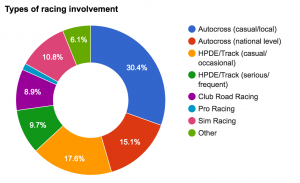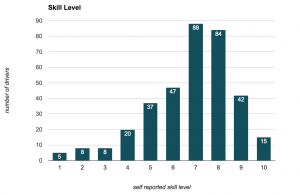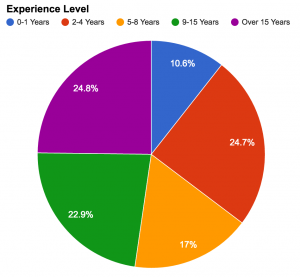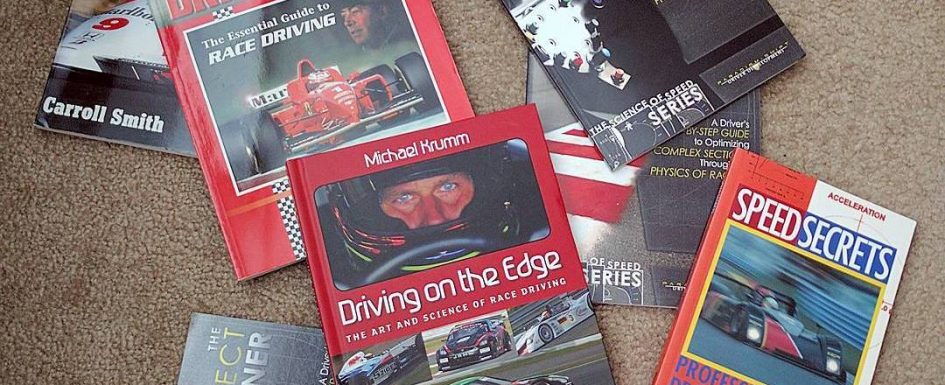This all began, as most things do, with failure.
A few years ago, I was frustrated with my lack of success at national level autocross. Sure, I was doing reasonably well, winning a Pro Solo event here and there and placing high up in the trophies at the national championships. But I felt like my progress was slowing, and there seemed to be a performance glass ceiling I was struggling to break through. Admitting that we are not performing as well as we would like is hard for a lot of us. It certainly was hard for me. It is a vulnerable feeling, and at first, I parroted the usual litany of excuses and justifications.
“I have other stuff going on that takes up my time.”
“This isn’t my career, so it’s not that important anyway.”
“I’m just doing this for fun!”
“My car isn’t prepped 100%.”
“I just need more seat time.”
But once I was able to be honest with myself and peer behind those words, I saw them for what they were; excuses to shield my ego from the reality that I would need to put forth a concerted effort to get faster. Even though it seems obvious that driving fast is a “learned” skill, most of us seem to have an odd reliance on the idea that we are naturally talented drivers who do not need to dissect, study, analyze, and learn more about going faster. It’s not dissimilar to the idea of a sprinter thinking they don’t need to do squats, work on balance, take care of nutrition, or understand their physiology and how to maximize muscular output, because running is something they do naturally. Sounds ridiculous doesn’t it?
“I just need more seat time” is probably the single most commonly repeated phrase by racers in every motorsports discipline. And certainly, I cannot refute the benefit of seat time. However, the stark reality is this: We will never get as much seat time as we would like. Some may get more than others, but everyone wants more seat time. So I began to wonder… if everyone is in the same boat, wanting more seat time… what ELSE do racers do in order to get faster? In particular, what are the successful drivers doing differently than the rest?
I started out by talking to friends, a few distant competitors, and a pro racer or two, and tried to piece together various opinions and insights into a learning system that worked for me. That’s when I thought, “Why limit this to a small set of people I know? Why not ask… well… everyone?”
A few months ago I put out a survey in an attempt to uncover what avenues, methods, and tools racers from various disciplines use to learn and improve… both when they are at the track, and when they are away from the track. I also attempted to understand what aspects of driving people are most interested in improving, and what drives them to improve in the first place. I was astounded to get over 350 responses to the survey! That is huge number when you consider how niche an activity performance driving is. I am especially thankful for the folks who gave very detailed answers that provided much deeper qualitative insight. Over the past couple of months, I went through various iterations of what to name this website. But as the insights from the survey became clear, the name “Beyond Seat Time” seemed most appropriate and fitting.
First, some classifications from the survey results:



There were some interesting correlations to observe in the responses:
- Regardless of the type of motorsports, high performing drivers (9’s and 10’s) are significantly more likely (85%) to seek out help from others than lower performing drivers (66%).
- Even more telling, high performing drivers are far more likely (91%) to spend time learning and studying while they are away from the track than lower performing drivers (52%).
- Road racers and club racers are the most likely to use sim racing as a learning tool when they are away from the track. HPDE drivers are the most likely to read books. Autocrossers are the most likely to watch lots of video.
- Drivers who have been involved for 0-8 years cite “talking to others” as one of their favorite methods of learning while at the track. Drivers who have been involved for 9+ years cite “talking to others” as one of the least effective methods of learning.
- Of all the skill levels, drivers who identify as 7’s are the most likely to just rely on themselves.
- Regardless of experience, skill level, or type of racing, the most common aspect of driving that everyone seems to want to work on is corner entry.
Although it is validating to have some data behind it, most of this is stuff that I suspect we already intuitively expected/knew. I doubt that too many of us are surprised to learn that high performing drivers spend more time studying their craft when they are away from the track, or that autocrossers are more likely to spend time studying videos (it is far easier to dissect and digest a 60 second video, than a 20 minute long recording of a session or a race). But the part that is worth being introspective and reflective about is that if we know these things to be intuitively true, why don’t more drivers put in the time and effort away from the track instead of reverting to the idea of just needing more seat time?
We get much more interesting insights when we dissect the data a bit further.
For example, let’s work with the assumption that it takes time for a driver to go through a normal progression to get really fast. With that assumption in mind, it would be telling to see what the differences in approach are between:
- Drivers who have been competing for a long time, but are stuck at a medium skill level (6-8)
- Drivers who have been competing for a long time, and have made it to the upper echelon (9-10)
- Drivers who have been competing for a shorter period of time, but have managed to progress to a high skill level quickly (9-10)
Looking at the data this way, we may be able to tell which methods of learning don’t work particularly well, which ones help a driver improve over time, as well as which ones help accelerate the progression.
When we look at medium skill drivers who have been competing for 9 years or more, a couple of patterns emerge. This group, as a whole, is less likely to seek help from others when they are at the track (62% vs 85% of high performers). Perhaps more importantly, when they do seek help from others (in the form of instructors, coaches, or just advice from other drivers), their primary criteria for selecting an instructor is how fast that person is. This behavior is in sharp contrast to how the high skill drivers choose instructors; they choose the best teachers. This information was gleaned from the qualitative answers people gave about how and why they choose instructors. I particularly liked how one of the high skill drivers phrased this:
“There are some people that have an understanding beyond their speed. Don’t discount someone’s ability to help you be faster just because they are not faster than you.”
We already know that the medium skill group is less likely to spend time working on their skills and knowledge when they are away from the track (52% vs 81% of high performers). In fact, the 6-8 skill level drivers who have been competing for over 15 years are the ones who most commonly used the phrase “I just need more seat time”. It is so perplexing to think that despite relying solely on that mindset for so many years, they cannot see that what they have been doing has not been working. High skill drivers are much more likely to read books, study video, and analyze data. As one particular driver put it: “Racing is physics, so it is essential to study.” High skill drivers who progressed relatively quickly do even more! In addition to reading and studying video, this group is more likely to take online courses and practice with sim racing (62% of high performing drivers who made quicker progress took online courses and/or used sim racing vs 35% of high performing drivers who took longer to get up to speed). The survey did not ask for the age of the participants, so I wonder if there is a generational component at play here, with younger drivers being more open minded to alternative sources of information when they are away from the track.
Similarly, to understand how a novice can most effectively progress up to intermediate level and beyond, we can take a look at the difference in approach between:
- Drivers who have been competing for 5 years or less, and are are a low skill level (1-5)
- Drivers who have been competing for 5 years or less, and are at a higher skill level (6+)
- Drivers who have been competing for 2 years or less, but have managed to progress to a higher skill level (6+)
The patterns that emerge are, unsurprisingly, very similar. The drivers who remain at a low skill level are the ones most likely to rely on their own and say that they just need more seat time. The drivers who made improvements over time sought out informal or formal schools, sessions with instructors, and got advice from fellow competitors. Interestingly, despite these drivers gaining tangible benefits from it, about 50% of them had an unfavorable opinion of informal schools. I’ll perhaps dig deeper into that in a future post. The drivers who made quicker progress were, once again, much more likely to spend time working on their skills away from the track through reading books and studying videos.
This may be eye opening to some of you, or it may be just what you expected. Either way, it is good to have some data to back up what seems intuitive. At the end of the day, racing is a physics dance, so excelling at it will, almost by definition, take not just practice but also study. Even the great driving coach and author Ross Bentley espouses that seat time alone is not the answer. And if we are serious about wanting to get better at drivers, it is time we finally put to bed the myth that we “just need more seat time”. Of course this is easier said than done; there are many real life hurdles, and some psychological hurdles in the way.
For some of us, there is the very real hurdle of not having enough time (“I have real life responsibilities”, “This is just a hobby”, etc). For some of us, there is skepticism that we can learn anything about driving from outside a car (“I can’t learn from books/online”, “I don’t want to spend money if it doesn’t put me on track”).
As with anything in life, if something is important enough to us, we can find a way to make it a priority. I have a hard time believing that we can’t find an hour in a week to read or study something we care about. Even the busiest amongst us easily wastes at least twice that much time in a week thumbing through Facebook, arguing on car forums, or on other activities that at the end of the day add minimal value to our lives. And as for skepticism about being able to learn anything about driving from outside a car, I think anyone who says that they can’t learn from something is doing themselves a disservice. It may behoove us to realize that our top competitors are doing these things, and unless we are ok with being left behind, we’d better figure out a way to overcome our preconceived notions about how we can and can’t learn. As the saying goes…
“You can lead a horse to the water, but you can’t make it drink.”


Excellent article, thanks for sharing.
Great article! One of the better ones I’ve read in quite a while.
I have much to say …. but more of a “let’s have a coffee or beer” and discuss this further kind of thing! 🙂 It is just too much to really discuss on the internet and its inherent limitations wrt communications.
We should talk at Nats some time … see if I make it this year. 🙂
Reijo
Looking forward to seeing you at nationals 🙂
Great survey and post. Well done
Thanks for this Vigo. Very insightful.
Great article backed up by some qualitative data. I agree, intuitively and scientifically. I have a saying “practice does not make perfect, perfect practice makes perfect”. To yours, and Ross Bentley’s, excellent assertion that “seat time alone is not the answer”, I agree. You do need more seat time, but that seat time must used with a purpose of working on improving particular go-faster skill. That purpose determined at the track (ie. coach, logger data analysis, etc.) and away from away from the track (ie. reading, disecting videos, sim driving, etc.). I like your phrase “…racing is a physics dance…”. Great metaphor! A great racer is like a great dancer: great posture, great poise, patience, unconscious muscle memory movements of the, hands, arms, and legs and feet; conscious movement of the head and eyes to monitor immediate surroundings and to target the next mark to hit. AND, as you eluded to, a great mindset that also requires introspection, working to change thought patterns that creating mental barriers, and learning what needs to be learned. AND great physical conditioning. And an understanding of the race car’s dynamics and its setup. Personally, I do all the above. For context, I have been a crew chief on a two car race team for four years. A circle track driver for two years. And a road race driver for 4 years. I also have a Ph.D. Degree in Engineering. I would self rate as an 8.5 out of 10. Keep on posting such informative articles.
Kevin, thank you for taking the time to post that awesome comment! With your background in engineering, I would love for us to connect and get (and share) some of your insights on this website! I am very interested in motivation, the psychology behind learning, and of course deeper insights about being the best driver possible. And it sounds like you would have some really good insights to share.
Great article Vivek. Very interesting. Thanks for taking the time to do the survey and figure out the results.
Very interesting ! Thank you for sharing your findings and your time !
Great look at some real data. And well thought out insight too. It’s funny how much I find myself telling new drivers “you just need more seat time”, but if I look at my own progression it involved more than just seat time. (And I still have a way’s to go.)
Ron, that’s the interesting thing! Even when we know better, and have done more, our automatic answer is always “more seat time”. It’s a fascinating psychological trap 🙂
Vivek,I appreciate the time and effort you have put into this. There are so many variables. I would definitely say those not willing to truly get better, pulls the “seat time” excuse. That reason is the most LAME of the bunch. I would say one component you did not mention was “humility”. True learning and growth come, when one is humble enough to know they “don’t know it all”. I’m a teacher and coach. The greatest improvement always is a product of a “willingness” to learn… that is “humility”.
David, you are correct. Certainly humility is an essential component for ANY learning to occur.
Conor McNally, I knew someone by that name. Hmm… Hope you’re doing well, even if you’re not who I’m thinking you are. Have a blessed week! DS
Thank you for this article. I had a conversation about this yesterday with a buddy who said he just needed more seat time. The timing was amazing, as is the data. Much appreciated!
Glad it proved helpful!
Vivek, thank you! This is a great article and parallels my own experience in the sport. The advent of in-car data and intelligent video collection (video with measures) has allowed drivers to leverage, extract more information and come up with MUCH more targeted goals for the next session. Without goals, and specifically the ability to measure the efficacy of the execution of those goals, more track time won’t help. Thanks again!
-Peter Krause
Vivek,
Excellent post and site! I agree with Peter Krause, a great driver coach. Whenever you are getting seat time for practice, you should have specific goals and be working on one or two specific things each session. Also, unless you get feedback from data or others, you just may be learning bad habits or repeating mistakes.
I am a track day person who also has raced shifter karts. I also have a Ph.D. in Clinical Psychology and would enjoy the opportunity to join the discussion.
Michael